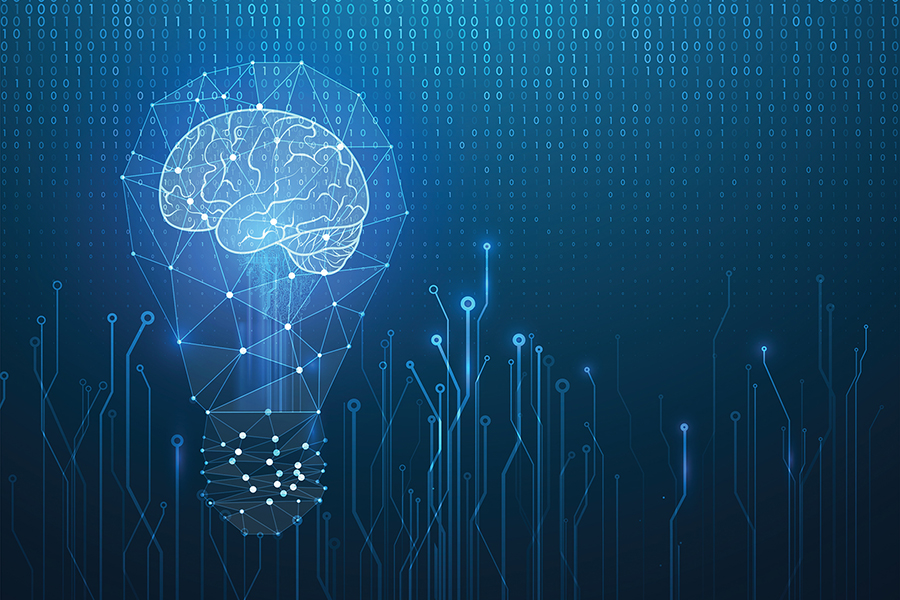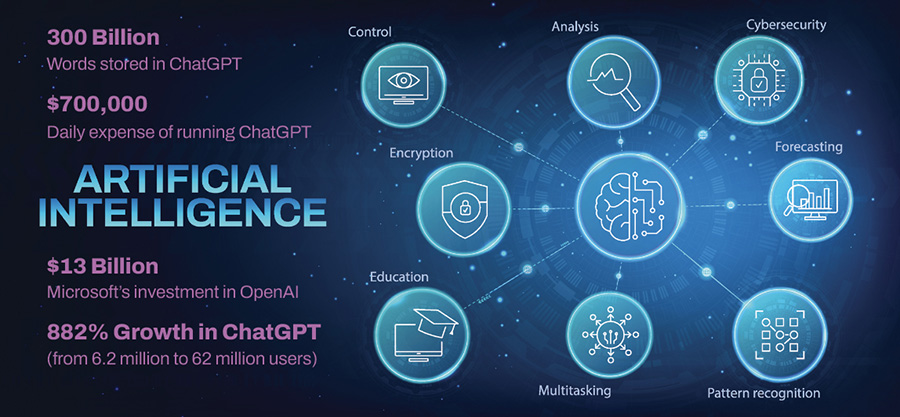- Apply
- Visit
- Request Info
- Give



Published on October 26, 2023
 In “The Terminator” movie franchise, humanity faces a recurring battle against an army of artificially intelligent, self-aware killing machines. In the initial 1984 movie, a cyborg travels back in time from 2029 to kill the mother of the human resistance leader.
In “The Terminator” movie franchise, humanity faces a recurring battle against an army of artificially intelligent, self-aware killing machines. In the initial 1984 movie, a cyborg travels back in time from 2029 to kill the mother of the human resistance leader.
It is now 2023 — only six short years from the apocalyptic war of director James Cameron’s vision — and the reality of artificial intelligence (AI) appears to be much more hopeful. While the concept of self-aware artificial intelligence is still unrealized, today’s rapid AI advancements pose great benefits for humankind, as revolutionary as the Internet itself. It is no surprise that AI has the interest of Eastern faculty, students and alumni, who are embracing — and bracing for — the burgeoning opportunities of artificial intelligence in today’s world.
Artificial intelligence in broad terms refers to the capability of computers to process enormous amounts of data at incredible computing speed to make highly accurate predictions or generate human-like output. Whereas “reactive” AI responds to data provided and has limited learning capacity — the spam filter on your email, for example — “limited memory” AI applications, such as floor vacuum robots and self-driving cars, are able to predict outcomes and be trained to operate in particular ways.
AI and machine learning are complex computer concepts, and many aspects of today’s modern life fall within their sphere: search engine prompts, targeted digital advertising, social media algorithms, customer service chatbots, virtual assistants like Siri and Alexa, navigation apps and others. Surveys suggest upward of 80% of all people now use AI-powered devices and applications. Television and radio commercials now highlight AI to sell automobiles, golf clubs, financial services and more.
ChatGPT, which stands for “generative pre-trained transformer,” is the newest trending AI platform, growing in usage by 882% from 2022 to 2023. A recent survey showed that 67% of IT officers want to use AI in some form in their business within the next 18 months. ChatGPT is a “large language model” created by OpenAI, a nonprofit research organization with a for-profit subsidiary.
The application is inspired by the neural networks of the human brain to process queries against a huge database of words (300 billion), generating responses that appear human-like, logical and accurate. The “bot” has been “trained,” using complex algorithms, to recognize human language patterns and structures. It improves its performance by rapidly adjusting output to represent the best match for the user’s query — the more precise the query, the more detailed the output.
 GPTs are not limited to text: Google “Lens” is a service provided by the search company that uses its massive databases to recognize and identify images — animals, plants, even text in more than 100 languages. DALL-E-2 is an image generation program that OpenAI has introduced that allows the user to generate digital images (illustrations, photos and other artwork) using natural language — again, the more complete the prompt, the more detailed the output. (“Draw a pen and ink illustration of a Buddhist monk tending his garden in China in the early morning light.”) Filmmaker George Lucas recently used AI to create a younger Harrison Ford for the newest Indiana Jones movie, and AI was used to generate digital voiceovers for videos at this year’s Master’s golf and U.S. Open tennis tournaments.
GPTs are not limited to text: Google “Lens” is a service provided by the search company that uses its massive databases to recognize and identify images — animals, plants, even text in more than 100 languages. DALL-E-2 is an image generation program that OpenAI has introduced that allows the user to generate digital images (illustrations, photos and other artwork) using natural language — again, the more complete the prompt, the more detailed the output. (“Draw a pen and ink illustration of a Buddhist monk tending his garden in China in the early morning light.”) Filmmaker George Lucas recently used AI to create a younger Harrison Ford for the newest Indiana Jones movie, and AI was used to generate digital voiceovers for videos at this year’s Master’s golf and U.S. Open tennis tournaments.
EASTERN AND AI
Professor Garrett Dancik, chair of Eastern’s Computer Science Department, says generative AI is in its early stages but has the potential to create many new career opportunities for Eastern graduates.
No stranger to the reality of AI, Eastern has been teaching the Artificial Intelligence course for more than 20 years. Additionally, Introduction to Programming and Machine Intelligence has been taught since 2019. Students in both courses are introduced to the concepts of large language models, deep learning, neural networks and other technical aspects of GPTs.
Dancik also teaches courses in Eastern’s bioinformatics minor and uses a basic form of AI for genomic data analysis to predict certain conditions, such as breast cancer, and whether they’re likely to spread over time. He stresses that “in the real world, AI cannot be used by itself to render diagnoses. A doctor must make the final call. AI is not a replacement for humans; it is a tool for humans to use.”

In the business information systems (BIS) program, courses in Business Intelligence and Emerging Technologies and Business Applications focus on AI-related business solutions and ethics in business settings.
“AI has the ability to look for non-obvious relationships in huge amounts of data,” said Professor Alex Citurs, BIS program coordinator. “AI is now being used by alumni to make better and faster decisions to support businesses in a fast-changing global world,” he said, adding that alumni are using AI at Pfizer to find secondary drug uses and at Cigna to find health insurance anomalies, among other applications.
One area of concern sparked by the introduction of ChatGPT is the potential for misuse on college campuses. Computer Science Professor Sarah Tasneem notes that some universities have banned the use of ChatGPT due to concerns over plagiarism. She believes AI should be embraced as a tool that can assist in teaching/learning and argues that faculty need to use innovative strategies to ensure students are personally engaged in their learning. First and foremost, she says faculty at Eastern can reaffirm the importance of integrity at the start of each semester. Students in Tasneem’s Programming and Machine Intelligence class also spend time talking about the ethics of computer technology.
Written assignments and term papers can be broken up into sections, making it more difficult to plagiarize. Tasneem also suggests that students be asked to orally explain their work individually and collaboratively, answering questions from their peers. Group assignments not only engage individual students, according to Tasneem, they help students improve their creative thinking and problem-solving skills.
Tasneem also sees AI as a means to aid educators. “AI tools can be used to generate personalized and adaptive quiz questions that dynamically adjust difficulty based on students’ responses.” She also sees the potential for platforms like ChatGPT to be used like research and study aids, so long as the outputs are fact-checked and not taken verbatim.
AI is not a replacement for humans; it is a tool for humans to use.
Garrett Dancik, computer science professor
Professor Joel Rosiene has taught the Artificial Intelligence course since 2005. In the course, students learn how to create a chatbot as well as AI-generated images. “It’s important at a liberal arts college for students to experience things and worlds outside their major; it opens them up to new perspectives,” said Rosiene, making the point that non-computer science majors can also benefit from AI-focused courses.
Rosiene is not without skepticism, however, explaining that while generative AI can make mistakes, there is no way the user can ask ChatGPT why it has come to a particular decision. Additionally, there are the “deep fakes” — photos, videos and quotations of celebrities that are complete fabrications. To those who are concerned that AI can become self-aware and put humans at existential risk, Rosiene says the ability of AI to take actions on its own is still conceptual.

Eastern’s computer science faculty are not limiting their work to the classroom. Tasneem and fellow professor Kehan Gao have received two NASA grants to apply AI to analyzing landforms on Mars. The two grants, totaling $10,000, allow the Computer Science Department to hire three seniors to work on the project, “Exploring the Potential of Deep Learning for Mars Image Classification and Analysis.”
The project will research the use of convolutional neural networks to classify images, seeking to overcome the limits of conventional classification methods, which struggle with the size of large image datasets, to improve efficiency and accuracy. Eastern is also funding summer curriculum development projects to allow computer science faculty to develop special topics in data science, including neural networks and deep learning.
Eastern students appreciate the University’s coursework in this emerging field. Senior computer science major Anish Ivaturi has taken both courses in AI and machine intelligence. “The faculty have provided a great introduction. These courses are valuable guidance on how to develop AI applications,” said Ivaturi, who wants to use AI in the medical field by building datasets of patient records to help generate correct diagnoses and “help doctors make better decisions.” Current online applications like WebMD and the Mayo Clinic are already using AI to serve doctors and their patients.
In their AI class, Ivaturi and other students were given pieces of code to create a game in which a dog looked for an apple in a maze. Different filters — for example, the dog was blind in one iteration — allowed students to manipulate the model. Ivaturi sees a growing job market for AI practitioners ranging from health care to banking to customer service. “People should not be scared of AI. It is better to be intrigued by it and learn how to use it as a tool; it will not replace humans.”

Senior Christian Deras-Rodriguez took the Introduction to Programming and Machine Intelligence course and enjoyed learning about Python programming. He is a math and economics double major with concentrations in actuarial science and business economics. An aspiring actuary, he interned this past summer at The Hartford, where he used generative AI for marketing purposes. “AI is the hot new technology spawning a wave of innovation and investment,” said Deras-Rodriguez. He and a fellow student used OpenAI to generate documentation on high-speed rail policy. “You need to know how to ask the right queries,” he explained, with their prompt yielding results on everything from congressional hearings to academic journals and news articles.
Jacob Cohen is a junior pursuing a dual major in business information systems and finance, aspiring for a career in business intelligence or financial analysis. Cohen took the Introduction to Programming and Machine Intelligence class and learned about such aspects of AI as natural language processing, K-Nearest Neighbor modeling and the SciKit Learn Python module. “I see AI eventually replacing most white-collar jobs with robotics taking most blue-collar ones,” said Cohen. “However, this will most likely occur many years from now and the hype around AI will probably fade soon for a time but will come back.
“(The current media attention) introduced AI to the general public,” continued Cohen. “While the infrastructure already existed in terms of the GPT model before ChatGPT, it provided a very sleek and user-friendly way for anybody to become familiar with the true power of AI.”
Alumni use AI in the field
While ChatGPT may have brought AI into the mainstream over the past year, several Eastern graduates have been using AI in their jobs for some time.
Business administration major Chris Coutu ’01 is currently in a two-year deployment with the Connecticut Army National Guard, serving as an innovation officer. Coutu previously worked as director of Artificial Intelligence, Data and Analytics (AIDA) Transformation at Stanley Black & Decker, managing and incorporating data for the company’s automated manufacturing processes. In the National Guard, Major Coutu works with the Coast Guard Research and Development Center, other government agencies, educational institutions, and private sector companies to leverage new technologies in such fields as avionics and robotics.
 “AI allows us to process lots of data quickly to solve a variety of problems,” said Coutu. For instance, AI is used in search-and-rescue missions at sea and is able to distinguish between white caps in the waves and humans needing rescue. “My Eastern education helped me a great deal, especially in the areas of management information systems and continuous improvement.” Coutu believes AI can enhance humans’ ability to process data efficiently and accurately. “AI has the potential to transform the way the military operates.”
“AI allows us to process lots of data quickly to solve a variety of problems,” said Coutu. For instance, AI is used in search-and-rescue missions at sea and is able to distinguish between white caps in the waves and humans needing rescue. “My Eastern education helped me a great deal, especially in the areas of management information systems and continuous improvement.” Coutu believes AI can enhance humans’ ability to process data efficiently and accurately. “AI has the potential to transform the way the military operates.”
Frank Cogliano ’12 works in sales for PEAK, a company that makes AI solutions for supply chain and inventory professionals in companies ranging in size from small building supply con-tractors to Pepsi. The company creates predictive AI tools so that its clients can deliver the right product at the right time and place to their customers. PEAK clients use historical and live data to make better decisions in managing their inventory and supply distribution.
“While most customers can benefit from the out-of-the-box features of our programs, our unique value proposition is that we can customize the software so that each customer has their own AI,” explained Cogliano, who majored in communication at Eastern. “I see AI as relieving people of mundane work so that they can be more strategic in their jobs.”
AI as a force of positive change and social equity
 Microsoft founder Bill Gates has an optimistic view of the future of AI. As a leader in the philanthropic arena, Gates believes AI has the ability to reduce some of the global inequities we face. He predicts AI-driven innovations in areas ranging from global climate change to education and health care. AI can be used to take over tasks ranging from filing medical claims to doctor’s notes, freeing people to provide better patient care, Gates wrote in his blog this past March.
Microsoft founder Bill Gates has an optimistic view of the future of AI. As a leader in the philanthropic arena, Gates believes AI has the ability to reduce some of the global inequities we face. He predicts AI-driven innovations in areas ranging from global climate change to education and health care. AI can be used to take over tasks ranging from filing medical claims to doctor’s notes, freeing people to provide better patient care, Gates wrote in his blog this past March.
Other innovations in the near future include AI-powered ultrasound machines and the development of life-saving medicines, said Gates. Developing better seeds, improving soil analysis and developing vaccines for livestock will help to feed the hungry.
In the office, Gates sees a host of innovations in the future, including the automation of document handling, customer service and sales; AI-enhancements to the Microsoft Office suite to help manage email and meeting schedules; and “personal agents” that work across all devices to assist people with meetings, communication and financial transactions.
Professor Tasneem has the same positive view. “AI has the ability to augment human capabilities, simplifying and accelerating various processes, expanding our problem-solving capabilities and enabling us to focus on higher-level tasks.”
The future of artificial intelligence
Earlier this year, director James Cameron (“The Terminator”) commented, “I think the weaponization of AI is the biggest danger ... you could imagine an AI in a combat theatre, the whole thing just being fought by the computers at a speed humans can no longer intercede, and you have no ability to deescalate.”
What Cameron is referring to is still theoretical — the idea that computers can become self-aware and capable of harming human beings. Even short of catastrophe, Professor Dancik comments: “The current concerns about lost jobs, data security and accuracy are all valid. We need to address them with economic policy and government regulations.”
The people at the heart of the development of AI — OpenAI, Microsoft, Facebook, Google, Amazon and others — as well as government officials, are working hard to support the advances and benefits of artificial intelligence, while also mitigating the dangers and legitimate concerns.
AI has the ability to augment human capabilities, simplifying and accelerating various processes, expanding our problem-solving capabilities and enabling us to focus on higher-level tasks.
Sarah Tasneem, computer science professor
With concerns over such issues as privacy, data security, copyright protection and others, in July 2023, seven major AI players committed to work with the federal government on a host of protections, including security testing by third-party experts, digital watermarking to distinguish AI- versus human-generated creative content, public reporting, licensing and safeguards to eliminate discrimination against minorities.
A week after the Biden administration announced the agreement, Microsoft, Anthropic, OpenAI and Google announced the creation of the Frontier Model Forum, an industry group tasked with researching safe AI development, independent evaluation of AI applications and collaboration with public policymakers. Climate change, cancer prevention and cybersecurity were of special note in the group’s plans.
The European Union is considering similar rules, and U.N. Secretary General Antonio Guterres has appointed a board to develop recommendations by the end of this year, creating global strategies similar to what was done with the International Atomic Energy Agency.
Written by Ed Osborn